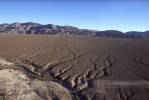Many of Zion Canyon’s wonders are easily accessible


The heart of Zion National Park in southeastern Utah is Zion Canyon, a magnificent chasm carved into the edge of the Colorado Plateau. This is where the North Fork of the Virgin River snakes its way downstream flanking the six-mile Zion Canyon Scenic Drive. The beauty of this area is complemented by the thick vegetation that lines the river including the impressive, old-growth Fremont cottonwood trees.
Less than three hours from Las Vegas, this landscape is available for all to see via a free shuttle bus from April through October; this bus is accessible for wheelchairs and other mobility devices (the rest of the year you can take a private vehicle on the drive). The bus, which leaves from the Zion Canyon Visitor Center, departs about every seven minutes and stops at eight locations along the scenic drive.
Whether riding the bus or driving, one great stop is the historic Zion Lodge. Its appearance suggests the rustic but palace-sized rural retreats built by tycoons a century ago. Photographs from Zion’s historic past line the walls, both in the lobby and upstairs in the dining room, which can be accessed by stairs or an elevator. The premises are generously supplied with comfortable couches and chairs for resting.
As you travel the scenic drive, you will see giant sandstone monoliths that rise up about 2,000 feet. Keep an eye out for some of the resident wildlife, including wild turkeys, mule deer and ringtail cats. There have also been more than 200 species of birds identified in the park, including some recent sightings of endangered California condors.
The premier trail in this canyon is the Riverside Walk, which starts at an elevation of 4,400 feet. This two-mile round-trip paved trail has a gradual 57-foot elevation change overall, and the maximum grade is 7 percent. This is a great trail for people with limited mobility, although wheelchairs may require some assistance. The trail does have drop-offs in some areas without railings. There is an accessible restroom available at the trailhead.
In spring you will see the canyon walls rich with hanging gardens of maidenhair ferns, columbine and shooting stars. These gardens thrive where water seeps from the sandstone cliffs. This time of year you might also be treated to the sight of dozens of waterfalls plummeting hundreds of feet off the high snow-packed cliffs. Also along the trail are desert swamps, where you will find more water loving plants such as horsetails, cattails and scouring rush. My hiking buddies and I have seen mule deer and even wild turkeys many mornings while on this trail.
The Riverside Walk is surrounded by Zion’s signature red and orange Navajo sandstone walls. These rocks, millions of years old, were formed in environments as varied as sand dunes and sea bottoms. Be aware that the walk is slippery when wet. The trail ends at the Gateway to the Narrows. This is where hardy folks drop into the water and make their way upstream using the river as their trail.
There are wheelchairs available for loan at the Zion Canyon Visitor Center and the Zion Lodge. The Zion Lodge has several accessible hotel rooms and one accessible cabin. Call 888-297-275 or visit www.zionlodge.com. Accessible camping is available at Watchman Campground by reservations at www.recreation.gov or 877-444-6777, or first-come, first-served at South Campground. Accessible ranger programs are available in the park, with different programs depending on when you visit. You can find the schedule on the park’s website, www.nps.gov.
Deborah Wall is the author of Base Camp Las Vegas: Hiking the Southwestern States” and “Great Hikes, A Cerca Country Guide,” published by Stephens Press. Dennis Boulton is a retired Nevada schoolteacher and geologist. They can be reached at deborabus@aol.com/.


















